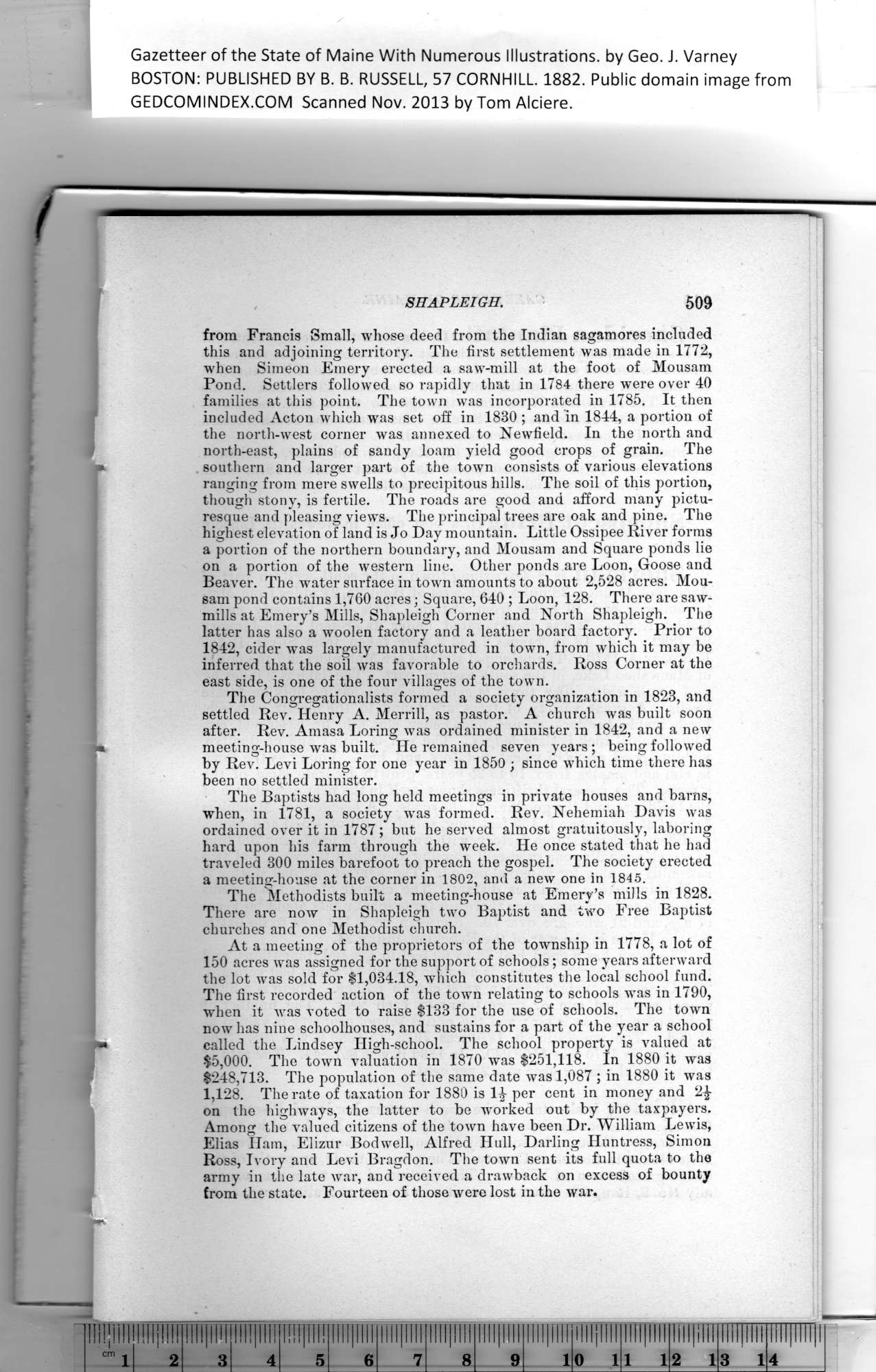|
Gazetteer of the State of Maine With Numerous Illustrations, by Geo. J. Varney
BOSTON: PUBLISHED BY B. B. RUSSELL, 57 CORNHILL. 1882. Public domain image from
509
from Francis Small, whose deed from the Indian sagamores included
this and adjoining territory. The first settlement was made in 1772,
when Simeon Emery erected a saw-mill at the foot of Mousam
Pond. Settlers followed so rapidly that in 1784 there wmre over 40
families at this point. The town was incorporated in 1785. It then
included Acton which was set off in 1830 ; and in 1844, a portion of
the north-west corner was annexed to Newfield. In the north and
north-east, plains of sandy loam yield good crops of grain. The
, southern and larger part of the town consists of various elevations
ranging from mere swells to precipitous hills. The soil of this portion,
though stony, is fertile. The roads are good and afford many pictu-
resque and pleasing views. The principal trees are oak and pine. The
highest elevation of land is Jo Day mountain. Little Ossipee River forms
a portion of the northern boundary, and Mousam and Square ponds lie
on a portion of the western line. Other ponds are Loon, Goose and
Beaver. The water surface in town amounts to about 2,528 acres. Mou-
sam pond contains 1,760 acres; Square, 640 ; Loon, 128. There are saw-
mills at Emery’s Mills, Shapleigh Corner and North Shapleigh. The
latter has also a woolen factory and a leather board factory. Prior to
1842, cider was largely manufactured in town, from which it may be
inferred that the soil was favorable to orchards. Ross Corner at the
east side, is one of the four villages of the town.
The Congregationalists formed a society organization in 1823, and
settled Rev. Henry A. Merrill, as pastor. A church was built soon
after. Rev. Amasa Loring was ordained minister in 1842, and a new
meeting-house was built. He remained seven years; being followed
by Rev. Levi Loring for one year in 1850 ; since which time there has
been no settled minister.
The Baptists had long held meetings in private houses and barns,
when, in 1781, a society was formed. Rev. Nehemiah Davis was
ordained over it in 1787; but he served almost gratuitously, laboring
hard upon his farm through the week. He once stated that he had
traveled 300 miles barefoot to preach the gospel. The society erected
a meeting-house at the corner in 1802, and a new one in 1845.
The Methodists built a meeting-house at Emery’s mills in 1828.
There are now in Shapleigh two Baptist and two Free Baptist
churches and one Methodist church.
At a meeting of the proprietors of the township in 1778, a lot of
150 acres was assigned for the support of schools; some years afterward
the lot was sold for $1,034.18, which constitutes the local school fund.
The first recorded action of the town relating to schools was in 1790,
when it was voted to raise $133 for the use of schools. The town
now has nine schoolhouses, and sustains for a part of the year a school
called the Lindsey High-school. The school property is valued at
$5,000. The town valuation in 1870 was $251,118. In 1880 it was
$248,713. The population of the same date was 1,087 ; in 1880 it was
1,128. The rate of taxation for 1880 is 1^ per cent in money and 2%
on the highways, the latter to be worked out by the taxpayers.
Among the valued citizens of the town have been Dr. William Lewis,
Elias Ham, Elizur Bodwell, Alfred Hull, Darling Huntress, Simon
Ross, Ivory and Levi Bragdon. The town sent its full quota to the
army in the late war, and received a drawback on excess of bounty
from the state. Fourteen of those were lost in the war.
PREVIOUS PAGE ... NEXT PAGE
This page was written in HTML using a program written in Python 3.2
|
